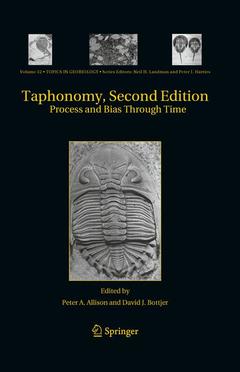Description
Taphonomy (2nd Ed., Softcover reprint of hardcover 2nd ed. 2011)
Process and Bias Through Time
Topics in Geobiology Series, Vol. 32
Coordinators: Allison Peter A., Bottjer David J.
Language: English
Subjects for Taphonomy:
Keywords
Fossil Preservation; Geology; Paleontology; Stratigraphy; Taphonomy
Publication date: 01-2013
600 p. · 15.5x23.5 cm · Paperback
Publication date: 11-2010
600 p. · 15.5x23.5 cm · Hardback
Description
/li>Contents
/li>Biography
/li>Comment
/li>
Taphonomic bias is a pervasive feature of the fossil record. A pressing concern, however, is the extent to which taphonomic processes have varied through the ages. It is one thing to work with a biased data set and quite another to work with a bias that has changed with time. This book includes work from both new and established researchers who are using laboratory, field and data-base techniques to characterise and quantify the temporal and spatial variation in taphonomic bias. It may not provide all the answers but it will at least shed light on the right questions.
1. Taphonomy; 2. Taphonomic overprints on biodiversity; 3. Taphonomy of shelly taxa through time; 4. Taphonomy of shelly taxa through time; 5. Taphonomy of animal organic skeletons though time; 6. Molecular taphonomy of plant organic skeletons; 7. The relationship between continental landscape evolution and the plant-fossil record; 8. Hierarchical control of terrestrial vertebrate taphonomy over space and time; 9. Taphonomy of carbonate microfacies through time; 10. Taphonomy of reefs through time; 11. Silicification through time; 12. Phosphatization through the Phanerozoic; 13. Three-dimensional morphological (CLSM) and chemical (Raman) imagery of cellularly mineralized fossils; 14. Taphonomy in temporally unique settings; 15. Taphonomy in temporally unique settings: the Ediacaran interval; 16. Mass extinctions and changing taphonomic processes.
Peter Allison graduated from the University of Hull with a Geology B.Sc. in 1983. After a short spell as a journalist writing market surveys for Industrial Minerals Magazine he went back to university to do a Ph.D. at the University of Bristol, graduating in 1987. Following post-doctoral positions at the University of Washington’s Friday Harbor Laboratories and the Department of Geology at Kochi University, Japan, he took a faculty position at the Postgraduate Research Institute for Sedimentology at the University of Reading. From there he joined the Earth Science and Engineering Department at Imperial College in 1997.
David J. Bottjer was born in New York City and attended Haverford College outside of Philadelphia (where he majored in Geology at neighboring Bryn Mawr College), and received an M.A. from the State University of New York at Binghamton and his Ph.D. from Indiana University (1978). After leaving Indiana he spent a post-doctoral year with the United States Geological Survey at the Smithsonian Institution in Washington, D.C. He began as Assistant Professor at the University of Southern California in 1979, where he is currently Professor of Earth and Biological Sciences and Chair of the Department of Earth Sciences. He has engaged in extensive professional service through his career, including a past editorship of Palaios, a present editorship of Palaeogeography, Palaeoclimatology, Palaeoecology, and election to the presidency of the Paleontological Society for 2004-2006
These books may interest you

Atlas of Taphonomic Identifications1001+ Images of Fossil and Recent Mammal Bone Modification 116.04 €



